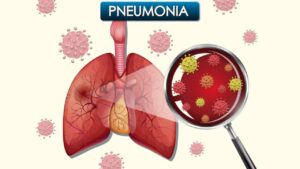
Pneumonia is a common and potentially serious respiratory infection that can affect people of all ages.
It occurs when the air sacs in the lungs, also known as alveoli, become inflamed and fill with fluid or pus, making it difficult to breathe.
Bacteria, viruses, fungi, or other pathogens can cause pneumonia, and the severity can range from mild to severe.
Prompt diagnosis, appropriate investigations, effective treatment, and prevention strategies are crucial in managing pneumonia and reducing its impact on overall health.
Diagnosing Pneumonia:
A healthcare provider typically begins diagnosing pneumonia with a comprehensive medical history and physical examination.
Common symptoms of pneumonia include cough, fever, chest pain, shortness of breath, and fatigue.
During the physical exam, the healthcare provider listens to the lungs with a stethoscope to check for crackling sounds, wheezing, or decreased breath sounds, which can indicate the presence of fluid in the lungs.
Various diagnostic tests may confirm the diagnosis and determine the underlying cause of pneumonia.
Healthcare providers commonly use Chest X-rays to visualize the lungs and identify areas of inflammation or infection.
A chest X-ray can show the presence of consolidation, a typical sign of pneumonia.
Other imaging tests, such as a computed tomography (CT) scan of the chest, may be performed for a more detailed assessment of the lungs.
Healthcare providers also conduct laboratory tests, including blood tests and sputum cultures, to help identify the specific pathogen responsible for the infection.
Blood tests can indicate the presence of infection by measuring elevated white blood cell counts and inflammatory markers.
Sputum cultures can help determine if the infection is bacterial, viral, or fungal in nature, guiding treatment decisions.
Investigations for Pneumonia:
In certain cases, additional investigations may be required to assess the severity and extent of pneumonia, as well as to identify any complications.
If a patient’s symptoms are severe or if the cause of pneumonia is unclear, further diagnostic procedures may be recommended.
A healthcare provider may perform bronchoscopy, a procedure in which a thin, flexible tube with a camera on the end is passed through the mouth or nose into the airways to obtain samples for testing.
Bronchoscopy can help identify the causative agent of pneumonia and assess the airway for any abnormalities.
Healthcare providers may perform pleural fluid analysis, which involves analyzing fluid collected from the space around the lungs if there is a suspicion of pleural effusion or empyema.
Other investigations, such as arterial blood gas analysis, may be used to evaluate the levels of oxygen and carbon dioxide in the blood, especially in patients with severe pneumonia or respiratory distress.
Healthcare providers may also conduct pulmonary function tests to assess lung function and capacity.
Treating Pneumonia:
The treatment of pneumonia depends on the underlying cause of the infection, the severity of symptoms, and the overall health of the patient.
Healthcare providers typically treat bacterial pneumonia with antibiotics, while viral pneumonia may require antiviral medications.
Fungal pneumonia is less common but may necessitate antifungal drugs for treatment.
Patients must follow their healthcare provider’s recommendations regarding medication dosages and duration to ensure that the infection is effectively treated.
In severe cases of pneumonia, hospitalization may be required to provide intravenous antibiotics, oxygen therapy, and close monitoring of respiratory function.
Supportive care plays a crucial role in the management of pneumonia and includes measures to alleviate symptoms and promote recovery.
Healthcare providers may prescribe pain relievers to manage chest discomfort, while cough suppressants can help reduce coughing.
Adequate hydration and rest are important for supporting the body’s immune response and aiding in the healing process.
Preventing Pneumonia:
Preventing pneumonia is an essential component of maintaining respiratory health and reducing the risk of infection.
Several strategies can help lower the likelihood of developing pneumonia, especially in high-risk populations.
Vaccination:
Vaccines are critical in preventing pneumonia caused by common pathogens, such as Streptococcus pneumoniae and influenza virus.
Healthcare providers recommend the pneumococcal vaccine and annual influenza vaccine for individuals at risk of respiratory infections, including young children, older adults, and individuals with chronic medical conditions.
Hand hygiene:
Practicing regular handwashing with soap and water, especially after coughing, sneezing, or touching surfaces in public areas, can help reduce the spread of respiratory pathogens.
Hand sanitizers containing at least 60% alcohol are also effective in killing germs.
Avoiding tobacco smoke:
Smoking and exposure to secondhand smoke can impair lung function and increase the risk of respiratory infections, including pneumonia.
Quitting smoking and avoiding tobacco smoke can help protect the lungs and overall respiratory health.
Good respiratory hygiene:
Covering your mouth and nose with a tissue or elbow when coughing or sneezing can prevent the spread of respiratory droplets that may contain infectious agents.
Proper disposal of tissues and regular cleaning of high-touch surfaces can further reduce the risk of transmission.
Maintaining a healthy lifestyle:
Eating a balanced diet rich in fruits, vegetables, and whole grains, staying physically active, getting enough sleep, and managing stress can support the immune system and overall health.
Regular exercise can also help strengthen respiratory muscles and improve lung function.
Regular medical check-ups:
Routine visits to a healthcare provider can help identify and manage underlying health conditions that may increase the risk of pneumonia.
Monitoring chronic medical conditions, such as asthma, chronic obstructive pulmonary disease (COPD), or diabetes, can help prevent respiratory complications and reduce the likelihood of pneumonia.
In conclusion, pneumonia is a significant respiratory infection that requires prompt diagnosis, appropriate investigations, effective treatment, and preventive measures to reduce its impact on health.
Understanding the signs and symptoms of pneumonia, seeking timely medical attention, and following recommended preventive strategies can help lower the risk of infection and support respiratory well-being.
By taking proactive steps to protect lung health and prevent pneumonia, individuals can enhance their overall health and quality of life.
Stay informed, stay vigilant, and prioritize respiratory health to reduce the burden of pneumonia and other respiratory infections.
Pneumonia treatment in mumbai – Dr Swapnil Gautam